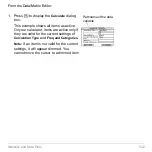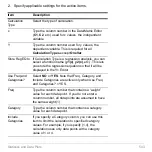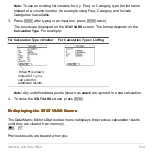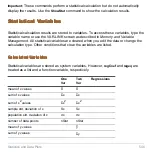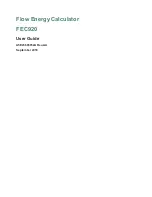
Data/Matrix Editor
534
Using the Shift Function
Using the Shift Function
Using the Shift Function
Using the Shift Function
The
shift
function copies a base column and shifts it up or down by a specified number of
elements. Use
†
to define a column header with the syntax:
For example, for a two-element shift up and down:
Note:
To enter shift, type it from the keyboard or select it from the CATALOG.
shift (
column
[,
integer
]
)
Ê
Ë
Ê
Column used as the base for the shift.
Ë
Number of elements to shift (positive shifts up; negative shifts down).
Default is
M
1.
Ê
Ë
Ì
Í
Î
Ê
c2=shift(c1,2)
Ë
c3=shift(c1,
M
2)
Ì
Shifted columns have the same length as the base
Í
Last two elements of c1 shift down and out the
bottom; undefined elements shift into the top.
Î
First two elements of c1 shift up and out the top;
undefined elements shift into the bottom.
Summary of Contents for Voyage 200
Page 36: ...Getting Started 36 D B D B Press Result ...
Page 45: ...Getting Started 45 3 0 D B D D B D Press Result ...
Page 46: ...Getting Started 46 D 2 0 0 2 D B Scroll down to October and press Press Result ...
Page 60: ...Getting Started 60 B D Press Result ...
Page 139: ...Previews 139 8 Complete the operation Press 2 d Steps and keystrokes Display 5 f 2 ...
Page 453: ...Differential Equation Graphing 453 ...
Page 468: ...Tables 468 ...
Page 777: ...Activities 777 ...























